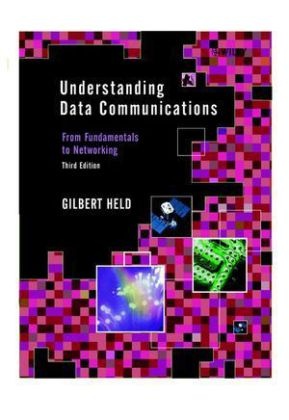Read more
Informationen zum Autor Gilbert Held is an internationally recognized author and lecturer who specializes in the applications of computer and communications technology. With over 30 years ofexperience in managing communications networks, he conducts seminars on topics that include LAN/WAN internetworking, data compression, and PC hardware and software. Held has written numerous books on computers and communications technology and has been recognized for his technical excellence in writing. Klappentext Datenübertragung - von den Grundlagen bis zur Netzwerktechnik! Die nunmehr 3. Auflage dieses äußerst erfolgreichen Lehrbuches bietet Studenten und Fachleuten gleichermaßen einen umfassenden Überblick über alle Grundkonzepte. Vorkenntnisse werden nicht vorausgesetzt. Der Leser profitiert von der jahrzehntelangen Lehrerfahrung des Autors: Der Stoff wurde leicht verständlich aufbereitet; Übungsaufgaben helfen bei der Vertiefung. Alle Abbildungen und Tabellen sind im Powerpoint-Format auf der beiliegenden CD enthalten. Zusammenfassung Aimed at the senior level undergraduate and graduate computer science student, this book provides an introduction to the field of data communications. Assuming no prior knowledge of the field, it explains of the role of communications, and the fundamental concepts of using the ISO's 7-layer approach to present the various aspects of networking. Inhaltsverzeichnis Preface xix Acknowledgements xxi 1 Communications in a Modern Society 1 1.1 Applications 1 1.1.1 Data collection 2 1.1.2 Transaction processing 3 1.1.3 Conversational time sharing 5 1.1.4 Remote job entry 7 1.1.5 Message switching 7 1.1.6 Value-added carriers and electronic mail 8 1.1.7 office automation 12 1.1.8 Electronic commerce 14 1.1.9 Satellite transmission 16 1.2 Constraints 16 1.2.1 Throughput 17 1.2.2 Response time 18 1.2.3 Bandwidth 18 1.2.4 Economics 19 1.3 Emerging Trends 19 1.4 Review Questions 20 2 Basic Telegraph and Telephone Operations 23 2.1 Evolution of Communications 23 2.2 Telegraphy 24 2.2.1 Operation 24 2.2.2 Morse code 26 2.2.3 Morse code limitations 27 2.2.4 Start-stop signaling and the Baudot code 28 2.2.5 Bits and codes 29 2.3 Telephony 32 2.3.1 Principle of operation 32 2.3.2 Sound wave conversion 34 2.3.3 The basic telephone connection 36 2.3.4 Switchboards and central offices 37 2.3.5 Numbering plans 39 2.3.6 Geographic calling areas and network routing 40 2.3.7The world numbering plan 43 2.4 Review Questions 43 3 Basic Circuit Parameters, Measurement Units and Media Overview 47 3.1 Basic Circuit Parameters 47 3.1.1 Frequency and bandwidth 47 3.1.2 The telephone channel passband 49 3.2 Measurement Units 50 3.2.1 Power ratios 50 3.2.2 Signal-to-noise ratio 52 3.2.3 Reference points 54 3.3 Media Overview 56 3.3.1 Twisted-pair cable 56 3.3.2 Coaxial cable 61 3.3.3 Microwave 63 3.3.4 Fiber-optic transmission 64 3.4 Channel Capacity 67 3.4.1 Bit versus baud 67 3.4.2 Nyquist relationship 67 3.4.3 Shannon's law 68 3.5 Structured Wiring 69 3.5.1 The wiring closet 69 3.5.2 The EIA/TIA-568 standard 69 3.6 Review Questions 72 4 Fundamental Data Transmission Concepts 75 4.1 Analog Line Connections 75 4.1.1 The analog switched line 76 4.1.2 Analog leased line 79 4.1.3 Dedicated line 82 4.1.4 Switched network vs leased line economics 83 4.2 Types of Service and Transmission Devices 84 4.2.1 Digital repeaters 85 4.2.2 Modems 86 4.2.3 Acoustic couplers 87 4.2.4 Analog facilities ...
List of contents
Preface.
Acknowledgements.
Communications in a Modern Society.
Basic Telegraph and Telephone Operations.
Basic Circuit Parameters, Measurement Units and Media Overview.
Fundamental Data Transmission Concepts.
Terminals, Workstations and WAN and LAN Networking Overview.
Representative Standards Organizations: the OSI Reference Model.
The Physical Layer, Cables, Connectors, Plugs and Jacks.
Basic Transmission Devices: Line Drivers, Modems, and Service Units.
Regulators and Carriers.
Transmission Errors: Causes, Measurements and Correction Methods.
The WAN Data Link Layer.
Increasing WAN Line Utilization.
Local Area Networks.
Basic LAN Internetworking.
Digital Transmission Systems and Equipment.
Network Architecture.
Packet Networks.
Communications Software.
Fiber-Optic, Satellite and Wireless Terrestrial Communications.
Evolving Technologies.
Index.
Report
"...designed to provide a solid foundation on how data communications systems operate, why, where, andwhen certain types of equipment should be networked together, and the role of evolving communications technology." (SciTech Book News, Vol. 25, No. 4, December 2001)

